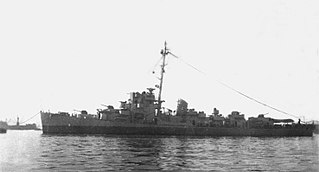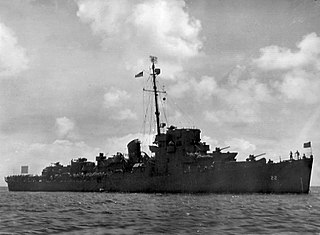
USS Mobile (CL-63) was a Cleveland-class light cruiser of the United States Navy. She was the third ship named for Mobile, Alabama.

USS Ramsay (DD-124) was a Wickes-class destroyer in the United States Navy during World War I, reclassified as DM-16 during World War II and again reclassified as AG-98. She was the first ship named for Rear Admiral Francis Ramsay.

USS Owen (DD-536), was a Fletcher-class destroyer of the United States Navy.

USS Stafford (DE-411) was a John C. Butler-class destroyer escort in the United States Navy. She was named after Richard Y. Stafford (1916–1942), a United States Marine Corps Captain who died during the Battle of Guadalcanal.

USS Cowell (DD-547), a Fletcher-class destroyer, was the second ship of the United States Navy to be named for John G. Cowell (1785–1814).

USS Moale (DD-693) was the second Allen M. Sumner-class destroyer of the United States Navy.

USS Marshall (DD-676) was a Fletcher-class destroyer of the United States Navy.

USS McDermut (DD-677) was a Fletcher-class destroyer of the United States Navy, the second Navy ship named for Lieutenant Commander David A. McDermut.

USS Porterfield (DD-682) was a Fletcher-class destroyer of the United States Navy. She was laid down by the Bethlehem Shipbuilding, San Pedro, California 12 December 1942; launched 13 June 1943; sponsored by Mrs Louis B. Porterfield and commissioned 30 October 1943, with Commander J. C. Woefel in command.

USS Russell (DD-414) was a World War II-era Sims-class destroyer in the service of the United States Navy, named after Rear Admiral John Henry Russell.

USS Stack (DD-406) was a Benham-class destroyer in the United States Navy. She was named for Edward Stack.

USS Meade (DD-602) was a Benson-class destroyer in the United States Navy during World War II. She was the second ship named for Richard Worsam Meade III and Robert Leamy Meade.

USS Steele (BDE-8/DE-8) was an Evarts-class short-hull destroyer escort in the service of the United States Navy.

USS Wileman (DE-22) was an Evarts-class destroyer escort constructed for the United States Navy during World War II. It was promptly sent off into the Pacific Ocean to protect convoys and other ships from Japanese submarines and fighter aircraft. At the end of the war, she returned to the United States proudly displaying four battle stars.

USS Whitman (DE-24) was an Evarts-class destroyer escort constructed for the United States Navy during World War II. It was promptly sent off into the Pacific Ocean to protect convoys and other ships from Japanese submarines and fighter aircraft. By the end of the war, when she returned to the United States, she had accumulated four battle stars.

USS Wesson (DE-184) was a Cannon-class destroyer escort built for the United States Navy during World War II. She served in the Pacific Ocean and provided escort service against submarine and air attack for Navy vessels and convoys. She returned home at war's end with a very respectable seven battle stars to her credit.

USS Bangust was a Cannon-class destroyer escort in service with the United States Navy from 1943 to 1946. In 1952, she was sold to Peru, where she served as BAP Castilla (D-61). She was decommissioned and scrapped in 1979.

USS Weaver (DE-741) was a Cannon-class destroyer escort in service with the United States Navy from 1943 to 1947. In 1952, she was sold to Peru, where she served as BAP Rodriguez (D-63) until being decommissioned and scrapped in 1979.

USS Straus (DE-408) was a John C. Butler-class destroyer escort in service with the United States Navy from 1944 to 1947. She was finally sunk as a target in 1973.

USS Conklin (DE-439) was a John C. Butler-class destroyer escort in service with the United States Navy from 1944 to 1946. She was scrapped in 1972. Conklin (DE-439) was named in honor of George Emerson Conklin who was posthumously awarded the Navy Cross for his brave actions on Guadalcanal.




















